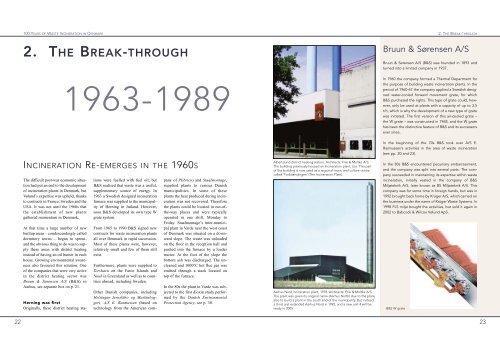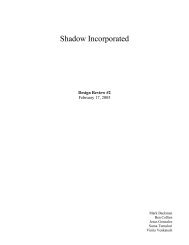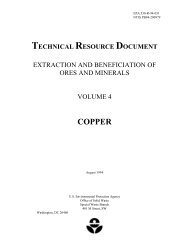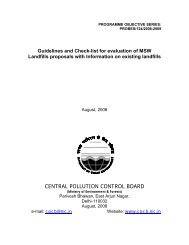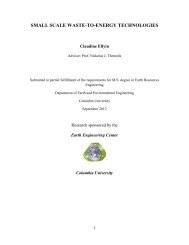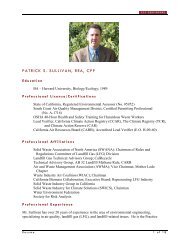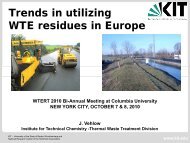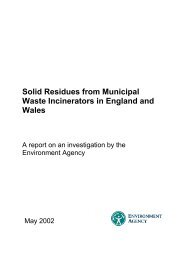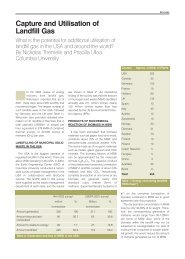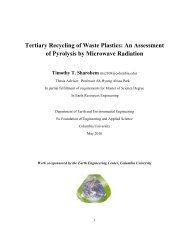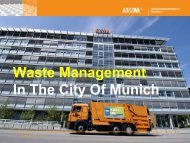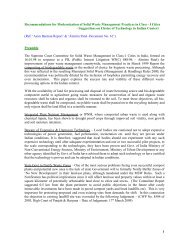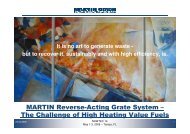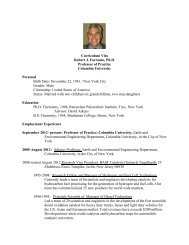100 YEARS OF WASTE INCINERATION IN DENMARK
100 YEARS OF WASTE INCINERATION IN DENMARK
100 YEARS OF WASTE INCINERATION IN DENMARK
You also want an ePaper? Increase the reach of your titles
YUMPU automatically turns print PDFs into web optimized ePapers that Google loves.
<strong>100</strong> <strong>YEARS</strong> <strong>OF</strong> <strong>WASTE</strong> <strong><strong>IN</strong>C<strong>IN</strong>ERATION</strong> <strong>IN</strong> <strong>DENMARK</strong><br />
2. THE BREAK-THROUGH<br />
1963-1989<br />
2. THE BREAK-THROUGH<br />
Bruun & Sørensen A/S<br />
Bruun & Sørensen A/S (B&S) was founded in 1893 and<br />
turned into a limited company in 1937.<br />
In 1960 the company formed a Thermal Department for<br />
the purpose of building waste incineration plants. In the<br />
period of 1960-67 the company applied a Swedish designed<br />
water-cooled forward movement grate, for which<br />
B&S purchased the rights. This type of grate could, however,<br />
only be used at plants with a capacity of up to 3.5<br />
t/h, which is why the development of a new type of grate<br />
was initiated. The first version of this air-cooled grate –<br />
the W grate – was constructed in 1968, and the W grate<br />
has been the distinctive feature of B&S and its successors<br />
ever since.<br />
<strong><strong>IN</strong>C<strong>IN</strong>ERATION</strong> RE-EMERGES <strong>IN</strong> THE 1960S<br />
The difficult post-war economic situation<br />
had put an end to the development<br />
of incineration plants in Denmark, but<br />
Vølund’s expertise was upheld, thanks<br />
to contracts in France, Sweden and the<br />
USA. It was not until the 1960s that<br />
the establishment of new plants<br />
gathered momentum in Denmark.<br />
At that time a large number of new<br />
builtup areas – condescendingly called<br />
dormitory towns – began to sprout,<br />
and the obvious thing to do was to supply<br />
these areas with district heating<br />
instead of having an oil burner in each<br />
house. Growing environmental awareness<br />
also favoured this solution. One<br />
of the companies that were very active<br />
in the district heating sector was<br />
Bruun & Sørensen A/S (B&S) in<br />
Aarhus, see separate box on p. 21.<br />
Herning was first<br />
Originally, these district heating stations<br />
were fuelled with fuel oil, but<br />
B&S realised that waste was a useful,<br />
supplementary source of energy. In<br />
1963 a Swedish designed incineration<br />
furnace was supplied to the municipality<br />
of Herning in Jutland. However,<br />
soon B&S developed its own type W<br />
grate system.<br />
From 1965 to 1990 B&S signed new<br />
contracts for waste incineration plants<br />
all over Denmark in rapid succession.<br />
Most of these plants were, however,<br />
relatively small and few of them still<br />
exist.<br />
Furthermore, plants were supplied to<br />
Torshavn on the Faroe Islands and<br />
Nuuk in Greenland as well as to countries<br />
abroad, including Sweden.<br />
Other Danish companies, including<br />
Helsingør Jernskibs- og Maskinbyggeri,<br />
A/S E. Rasmussen (based on<br />
technology from the American company<br />
of Plibrico) and Staalmontage,<br />
supplied plants to various Danish<br />
municipalities. In some of these<br />
plants the heat produced during incineration<br />
was not recovered. Therefore<br />
the plants could be located in out-ofthe-way<br />
places and were typically<br />
operated in one shift, Monday to<br />
Friday. Staalmontage’s inter-municipal<br />
plant in Varde near the west coast<br />
of Denmark was situated on a downward<br />
slope. The waste was unloaded<br />
on the floor in the reception hall and<br />
pushed into the furnace by a loader<br />
tractor. At the foot of the slope the<br />
bottom ash was discharged. The uncleaned<br />
and <strong>100</strong>0°C hot flue gas was<br />
emitted through a stack located on<br />
top of the furnace.<br />
In the 80s the plant in Varde was subjected<br />
to the first dioxin study performed<br />
by the Danish Environmental<br />
Protection Agency, see p. 30.<br />
Albertslund district heating station. Architects: Friis & Moltke A/S.<br />
The building previously housed an incineration plant, too. This part<br />
of the building is now used as a regional music and culture centre<br />
called ‘Forbrændingen’ (The Incineration Plant).<br />
Aarhus Nord incineration plant, 1978. Architects: Friis & Moltke A/S.<br />
The plant was given its original name (Aarhus North) due to the plans<br />
also to build a plant in the south end of the municipality. But instead,<br />
a third unit extended Aarhus Nord in 1992, and a new unit 4 will be<br />
ready in 2005.<br />
In the beginning of the 70s B&S took over A/S E.<br />
Rasmussen’s activities in the area of waste incineration<br />
(see pp. 20 and 23).<br />
In the 80s B&S encountered pecuniary embarrassment,<br />
and the company was split into several parts. The company<br />
succeeded in maintaining its expertise within waste<br />
incineration, initially vested in the company of B&S<br />
Miljøteknik A/S, later known as BS Miljøteknik A/S. This<br />
company was for some time in foreign hands, but was in<br />
1992 brought back home by Krüger A/S, which carried on<br />
the business under the name of Krüger Waste Systems. In<br />
1998 FLS miljø bought the activities, but sold it again in<br />
2002 to Babcock & Wilcox Vølund ApS.<br />
B&S W grate<br />
22<br />
23


